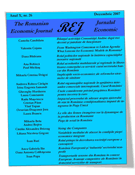Abstract:
This paper attempts to revisit the geometry of the demand and supply functions in economic analysis, taking mathematical exigencies into account. Leaning on the fundamental principles that guide the theory of demand and supply, the paper uses the analytical approach of data analysis to address the objectives of the investigation. Results of the study indicate that whether expressed in the standard mathematical form (Quantity-price relation) or casual mathematical form (Price-quantity relation), the demand and supply functions obey the laws of demand and supply. Also, the results reveal that the first component in the computation of the price-elasticity remains unchanged and takes into account the quantity-price relationship, irrespective of the functional form (Quantity-price function or price-quantity function) used in defining the demand and supply functions. Furthermore, the results show that the consumer and producer surpluses can still be evaluated without violating mathematical requirements with the quantity-price relation model of describing the demand and supply functions to accommodate welfare issues associated with the demand and supply concepts. As a result, it is suggested that mathematical requirements of logic, rigor, consistency, and objectivity be strictly respected when subjecting the analysis of real world economic phenomena to mathematical treatments.
